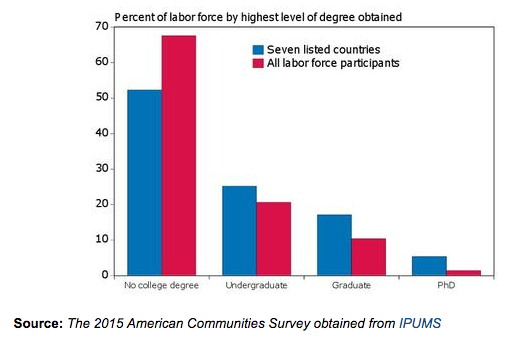Trump wants to block immigrant workers companies need
Immigrants are an underappreciated force in the US economy: They help boost economic growth, even though many Americans think they steal jobs and sap economic vitality.
President Trump wants to reduce immigration to the United States, starting with his attempted ban on immigrants from 7 predominantly Muslim countries—Iraq, Iran, Syria, Yemen, Libya, Sudan and Somalia. That ban has been temporarily blocked, as courts debate whether it’s legal. But Trump says a revised immigration order is coming soon–and reduced immigration is one part of Trump’s agenda economists worry about. “We already see a fairly subdued outlook for the pace of measured potential growth,” Goldman Sachs said in a recent note to clients. “Immigration restrictions could reduce the economy’s ‘speed limit’ still further.”
New analysis by the Conference Board of actual immigrants from the 7 countries Trump is targeting helps explain why the US economy needs legal immigrants. During the last 10 years, about 230,000 people have entered the US legally from those countries. About 109,000 are in the US labor force. They represent two types of workers, in general—well-educated professionals, including many who came to the US on a student visa, and less-skilled workers who most likely came as refugees.
Overall, workers from the Targeted 7 hold more bachelor’s and advanced degrees than US workers as a whole, as this chart shows:

At the lower end of the skill ladder, immigrants from the Targeted 7 are overrepresented in industries such as retail and health care, holding jobs such as food preparation and personal care. Health care in particular is a fast-growing field where the United States seems certain to need more workers in the future, and might even face a labor shortage in some areas.
Immigration is more important to the US economy than it used to be, because the native-born US population is growing more slowly than it has in the past. The Goldman Sachs analysis points out that immigration as a portion of total population growth has risen from 30% in the 1990s to as high as 50% now.
Some people think that means more immigrants are taking jobs native-born Americans would otherwise have. There are probably isolated incidents of that, but overall, there’s scant evidence that immigrants reduce the number of jobs available to natives. More likely, they increase the overall number of jobs, because immigrants start businesses at a higher rate and are more entrepreneurial than the US labor force overall.
Losing high-skilled workers
Trump pushed for an immigration ban on the Targeted 7 countries by claiming that terrorists were more likely to enter the United States from those countries. But when asked in court to produce evidence to support that claim, the Trump administration didn’t have any. Economic growth obviously needs to be balanced with national security, but if there’s no actual threat under the current vetting system, then locking out immigrants who would otherwise add to economic growth is self-defeating. Especially since Trump has vowed to double current rates of growth, to a robust 3.5% or even 4% per year.
Immigrants from the Targeted 7 are a very small fraction of all immigrants to the US. If Trump’s ban is reinstated, losing those workers could hurt a few select parts of the economy. “While they comprise only a tiny part of the US population overall, their disproportionate representation in certain high-skilled, high-shortage occupations and in certain metro areas means that losing their participation in the US labor market would produce tangible economic effects,” the Conference Board concluded.
If there are broader efforts to limit immigration, the effects will be more widespread. That could also offset other Trump initiatives that could genuinely boost growth, such as tax reform (if done right) and a cutback in onerous regulations. Terrorists are a legitimate enemy. Immigrants are not. If Trump doesn’t differentiate between them, the whole economy will suffer.
Confidential tip line: rickjnewman@yahoo.com
Rick Newman is the author of four books, including Rebounders: How Winners Pivot from Setback to Success. Follow him on Twitter: @rickjnewman.
Read more:

 Yahoo Finance
Yahoo Finance 
